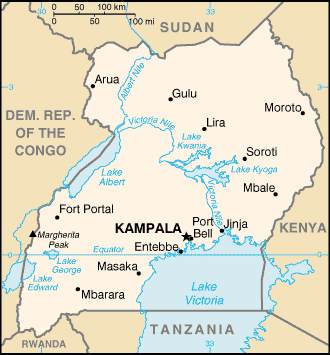Country name:
conventional long form: Republic of Uganda conventional short form:Uganda

Government type:
republic

Capital:
name:Kampalageographic coordinates:0 19 N, 32 33 E time difference:UTC+3 (8 hours ahead of Washington, DC, during Standard Time)

Administrative divisions:
111 districts and 1 capital city*; Abim, Adjumani, Agago, Alebtong, Amolatar, Amudat, Amuria, Amuru, Apac, Arua, Budaka, Bududa, Bugiri, Buhweju, Buikwe, Bukedea, Bukomansimbi, Bukwa, Bulambuli, Buliisa, Bundibugyo, Bushenyi, Busia, Butaleja, Butambala, Buvuma, Buyende, Dokolo, Gomba, Gulu, Hoima, Ibanda, Iganga, Isingiro, Jinja, Kaabong, Kabale, Kabarole, Kaberamaido, Kalangala, Kaliro, Kalungu, Kampala*, Kamuli, Kamwenge, Kanungu, Kapchorwa, Kasese, Katakwi, Kayunga, Kibaale, Kiboga, Kibuku, Kiruhura, Kiryandongo, Kisoro, Kitgum, Koboko, Kole, Kotido, Kumi, Kween, Kyankwanzi, Kyegegwa, Kyenjojo, Lamwo, Lira, Luuka, Luwero, Lwengo, Lyantonde, Manafwa, Maracha, Masaka, Masindi, Mayuge, Mbale, Mbarara, Mitooma, Mityana, Moroto, Moyo, Mpigi, Mubende, Mukono, Nakapiripirit, Nakaseke, Nakasongola, Namayingo, Namutumba, Napak, Nebbi, Ngora, Ntoroko, Ntungamo, Nwoya, Otuke, Oyam, Pader, Pallisa, Rakai, Rubirizi, Rukungiri, Sembabule, Serere, Sheema, Sironko, Soroti, Tororo, Wakiso, Yumbe, Zombo

Independence:
9 October 1962 (from the UK)

National holiday:
Independence Day, 9 October (1962)

Constitution:
several previous; latest adopted 27 September 1995, promulgated 8 October 1995; amended many times, last in 2005 (2011)

Legal system:
mixed legal system of English common law and customary law

International law organization participation:
accepts compulsory ICJ jurisdiction with reservations; accepts ICCt jurisdiction

Suffrage:
18 years of age; universal

Executive branch:
chief of state:President Lt. Gen. Yoweri Kaguta MUSEVENI (since seizing power on 26 January 1986); Vice President Edward SSEKANDI (since 24 May 2011) note - the president is both chief of state and head of governmenthead of government:President Lt. Gen. Yoweri Kaguta MUSEVENI (since seizing power on 26 January 1986); Prime Minister Amama MBABAZI (since 24 May 2011); note - the prime minister assists the president in supervising the cabinet cabinet:Cabinet appointed by the president from among elected legislators elections:president elected by popular vote for a five-year term; election last held on 18 February 2011 (next to be held in 2016) election results:Lt. Gen. Yoweri Kaguta MUSEVENI re-elected president; percent of vote - Lt. Gen. Yoweri Kaguta MUSEVENI 68.4%, Kizza BESIGYE 26.0%, other 5.6%

Legislative branch:
unicameral National Assembly (375 seats; 238 members elected by popular vote, 112 women directly elected, 25 nominated by legally established special interest groups [army 10, disabled 5, youth 5, labor 5], additional ex-officio members may be nominated by the president; members serve five-year terms)elections:last held on 18 February 2011 (next to be held in 2016) election results:percent of vote by party - NA; seats by party - NRM 263, FDC 34, DP 12, UPC 10, UPDF 10, CP 1, JEEMA 1, independents 43, vacant 1; note - UPDF is the Uganda People's Defense Force

Judicial branch:
highest court(s):Supreme Court of Uganda (consists of the chief justice and 5 justices)judge selection and term of office:justices appointed by the president in consultation with the Judicial Service Commission (a 9-member independent advisory body) and with approval of the National Assembly; justices serve until mandatory retirement at age 70 subordinate courts:Court of Appeal (also sits as the Constitutional Court); High Court (includes 10 High Court Circuits and 7 High Court Divisions); Chief Magistrate Grade One and Grade Two Courts

| | Political parties and leaders:
Conservative Party or CP [Ken LUKYAMUZI]Democratic Party or DP [Norbert MAO] Forum for Democratic Change or FDC [Muntu MUGISHA] Inter-Party Co-operation or IPC (a coalition of opposition groups) Justice Forum or JEEMA [Asuman BASALIRWA] National Resistance Movement or NRM [Yoweri MUSEVENI] Peoples Progressive Party or PPP [Bidandi SSALI] Ugandan People's Congress or UPC [Olara OTUNNU] note:a national referendum in July 2005 opened the way for Uganda's transition to a multi-party political system

Political pressure groups and leaders:
Lord's Resistance Army or LRA [Joseph KONY]

International organization participation:
ACP, AfDB, AU, C, COMESA, EAC, EADB, FAO, G-77, IAEA, IBRD, ICAO, ICC (NGOs), ICRM, IDA, IDB, IFAD, IFC, IFRCS, IGAD, ILO, IMF, Interpol, IOC, IOM, IPU, ISO (correspondent), ITSO, ITU, ITUC (NGOs), MIGA, NAM, OIC, OPCW, PCA, UN, UNAMID, UNCTAD, UNESCO, UNHCR, UNIDO, UNOCI, UNWTO, UPU, WCO, WFTU (NGOs), WHO, WIPO, WMO, WTO

Diplomatic representation in the US:
chief of mission:Ambassador Oliver WONEKHA (since 6 June 2013)chancery:5911 16th Street NW, Washington, DC 20011 telephone:[1] (202) 726-7100 through 7102, 0416 FAX:[1] (202) 726-1727

Diplomatic representation from the US:
chief of mission:Ambassador Scott H. DELISI (since 18 July 2012)embassy:1577 Ggaba Road, Kampala mailing address:P. O. Box 7007, Kampala telephone:[256] (414) 259 791 through 93, 95 FAX:[256] (414) 259-794

Flag description:
six equal horizontal bands of black (top), yellow, red, black, yellow, and red; a white disk is superimposed at the center and depicts a grey crowned crane (the national symbol) facing the hoist side; black symbolizes the African people, yellow sunshine and vitality, red African brotherhood; the crane was the military badge of Ugandan soldiers under the UK

National symbol(s):
grey crowned crane

National anthem:
name:'Oh Uganda, Land of Beauty!'lyrics/music:George Wilberforce KAKOMOA note:adopted 1962 |











